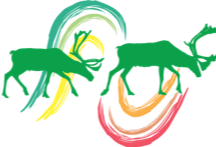Cumulative Effects Assessment of Four Barren-Ground Caribou Herds in the NWT
SUMMARY
Graphic recording by Nigit’sil Norbert (2021)
The Cumulative Effects Assessment of Four Barren-Ground Caribou Herds in the NWT aims to collaboratively develop a decision-support tool with Renewable Resource Boards (RRBs) and the Wildlife Management Advisory Council (WMAC) (NWT) to examine the cumulative effects of land-use, harvest management, natural environmental and climate change scenarios on the Bluenose West (BNW), Bluenose East (BNE), Cape Bathurst (CB) and Tuk Peninsula (TP) barren-ground caribou herd habitats and population dynamics.
o A barren-ground caribou research project – The project aims to share and build understanding of the cumulative effects of land use, harvest, and climate to barren ground caribou herds
o A collaborative approach among NWT wildlife co-management authorities- Key barren ground caribou interests are involved in the design, assessment and review of the research. Nunavut wildlife management authorities have been invited to participate
o Project funders – the Barren Ground Herd CEA is funded by NWT CIMP, Environment Canada and GNWT ENR
o Research priorities developed collaboratively - Specific research priorities are being set in collaboration with partners and management authorities
Research over three years - Results will be produced and communicated over the next three years.The project is designed to help address the recommendations of the NWT Recovery Strategy for Barren-ground Caribou (July 2020) and items from the herd specific Action Plans developed under the Taking Care of Caribou Plan.
Contact
Karin Clark, Principal Investigator. Environment and Natural Resources Government of the Northwest Territories - Karin_Clark@gov.nt.ca.
PROJECT PARTNERS
Graphic recording by Nigit’sil Norbert (2021)
The project is supported by the wildlife co-management boards in the NWT and Nunavut.
Project funders include:
· NWT Cumulative Impact Monitoring Program (CIMP)
· Environment Canada’s Aboriginal Funding for Species at Risk program (ASFAR)
· Parks Canada and
· NWT ENR
· In-kind contributions are provided by all project partners
Project partners include:
· Wildlife Management Advisory Committee (NWT)
· Gwich’in Renewable Resources Board (GRRB)
· Sahtú Renewable Resource Board (SRRB)
· Wek'èezhìı Renewable Resources Board (WRRB)
· Parks Canada Tuktut Nogait National Park
· Government of the Northwest Territories (GNWT ENR)
· ALCES Landscape and Land-use Ltd (ALCES)
Invited participants include:
· Kitikmeot Regional Wildlife Board
· Kugluktuk Angohanat Association
· Nunavut Wildlife Management Board
APPROACH
Graphic recording by Nigit’sil Norbert (2021)
The project is being led by project partners and guided by community and scientific knowledge holders:
· Project partners will manage the project and work to coordinate with communities to integrate information and collaborate
· Community and scientific knowledge holders will meet annually, in regional workshops, to discuss knowledge, develop a common understanding of key indicators and results, and discuss the implications on conservation management and next steps. The first workshops are being planned for the Fall of 2021
Partner Research Questions
The project can answer a number of key research questions relevant to communities and current management plan recommendations, including those in the Taking Care of Caribou report.
KNOWLEDGE AND RESEARCH
The cumulative effects of land use, natural disturbance, wildlife harvest, and climate on barren-ground caribou are being examined using ALCES Online (www.alces.ca), a web-based decision support tool for land-use planning and wildlife management that links landscape change to caribou population. The landscape simulator will be used to understand potential future changes related to fire, vegetation, roads and industrial development. The caribou population simulator will be used to explore how a herd may respond to landscape and climate change, as well as harvest.
Identify Priority Research Questions and Review Output
Graphic recording by Nigit’sil Norbert
Priority research questions are identified based on interviews with project partners. The questions form a basis for defining possible scenarios of the future and then conducting simulations to examine cumulative effects on caribou populations. The results of future landscape and caribou population simulations will be reviewed with project partners and knowledge holders at regional workshops. The base landscape and population models will be updated and new simulations run based on the feedback received.
Simulate Landscape Change
The landscape simulator uses map-based information on current natural land cover, human and industrial activity, forest disturbance (i.e., wildfires), and current and projected future climate. The data layers were prepared using the most up to date sources available[1]. Future landscape change will be simulated by projecting key land use sectors (e.g., mining, oil and gas, transportation) and fire.
Simulate Caribou Population Change
The ALCES population model simulates wildlife population change in response to habitat, productivity (number of calves born), and mortality. It is a cell-based spatial model that is linked to landscape simulations so that habitat and mortality risk respond to landscape and climate dynamics.
The project is currently identifying key model inputs, including seasonal ranges, initial population size and composition, productivity, mortality, and the effect of climate on these vital rates. In addition, work is being done to identify seasonal habitat associations for each herd.
PROJECT OUTCOMES
The project is being designed to achieve the following:
Collaboration and integration of historical research and monitoring data, including available Indigenous Knowledge,
Simulation modelling of the cumulative effects of landscape changes (e.g., climate, fire), project developments (e.g., roads), and management practices (e.g., harvest levels) on caribou populations
Identification of key uncertainties in our understanding to help inform monitoring priorities
Assessment of the contribution of potential land management and mitigation strategies that may help maintain resiliency of the caribou herds and their habitat
Development of transparent and plain language information to share with communities and the public about the potential changes and relative risks of differing management approaches
Appendix A: Technical Methods Report
Appendix B: Barren Ground Caribou CEA Land Use Scenarios 2022-2072
Appendix C: Ingenious Knowledge of TP, CB, BNW and BNE Herds
Appendix D: Table of Indigenous Knowledge
Appendix E: CBGC ALCES Online Training
Key project outcomes will be posted here as they become available.







